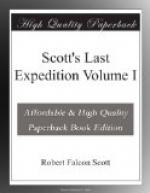Besides the problem of the form of the shoes, comes the question of the means of attachment. All sorts of suggestions were made last night as to both points, and the discussion cleared the air a good deal. I think that with slight modification our present pony snow-shoes made on the grating or racquet principle may prove best after all. The only drawback is that they are made for very soft snow and unnecessarily large for the Barrier; this would make them liable to be strained on hard patches. The alternative seems to be to perfect the principle of the lawn mowing shoe, which is little more than a stiff bag over the hoof.
Perhaps we shall come to both kinds: the first for the quiet animals and the last for the more excitable. I am confident the matter is of first importance.
Monday, August 14.—Since the comparatively short storm of Friday, in which we had a temperature of -30 deg. with a 50 m.p.h. wind, we have had two delightfully calm days, and to-day there is every promise of the completion of a third. On such days the light is quite good for three to four hours at midday and has a cheering effect on man and beast.
The ponies are so pleased that they seize the slightest opportunity to part company with their leaders and gallop off with tail and heels flung high. The dogs are equally festive and are getting more exercise than could be given in the dark. The two Esquimaux dogs have been taken in hand by Clissold, as I have noted before. He now takes them out with a leader borrowed from Meares, usually little ‘Noogis.’ On Saturday the sledge capsized at the tide crack; Clissold was left on the snow whilst the team disappeared in the distance. Noogis returned later, having eaten through his harness, and the others were eventually found some two miles away, ‘foul’ of an ice hummock. Yesterday Clissold took the same team to Cape Royds; they brought back a load of 100 lbs. a dog in about two hours. It would have been a good performance for the best dogs in the time, and considering that Meares pronounced these two dogs useless, Clissold deserves a great deal of credit.




